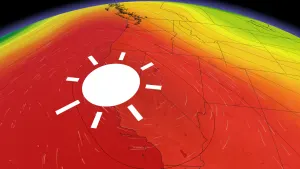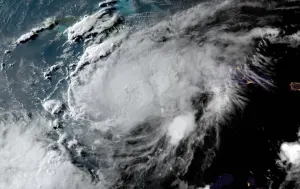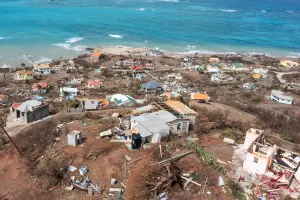
N.W.T. fire crews eye direct attack on Yellowknife wildfire
Visit The Weather Network's wildfire hub to keep up with the latest on the unprecedented wildfire season across Canada.
Wildland firefighters working on the out-of-control wildfire burning to the northwest of Yellowknife are hoping they can hit the fire head-on as warm, windy weather returns Sunday.
Yellowknife was sitting at 19 C Sunday morning with a high of 21 C predicted for the day. Winds out of the northwest around noon, gusting up to 35 km/h, are expected to wake up that wildfire and possibly push it toward the city.
"We're going to be looking at it this morning to see if we can put boots on the ground at the head of the fire and begin direct attack to slow down certain sections of this fire," said Mike Westwick, N.W.T. fire information officer.
The wildfire triggered the evacuation of the city of about 20,000 people, the neighbouring Yellowknives Dene communities of Ndilǫ and Dettah and residences along the Ingraham Trail last week.
The N.W.T. communities of Fort Smith, Enterprise, Hay River, Kátł'odeeche First Nation, Kakisa and Jean Marie River are also under evacuation orders due to wildfires.

NWT Fire said in its Sunday morning update it is possible the fire threatening Yellowknife will move four or five kilometres in the day, though air tankers can slow that. Teams will be doing infrared scanning of the fire's perimeter to get a handle on whether a direct attack is feasible.
Westwick said when it comes to larger fires, firefighters tend to use an indirect approach — fuel breaks and ignition operations, for example. The intensity of this fire has challenged crews' ability to attack it head-on so far.
At last update, this wildfire had been mapped at about 167,000 hectares in size — about 1,670 square kilometres burned — and it was about 15 kilometres west of the city. Rain that fell Saturday helped keep it in check temporarily.
WATCH NOW: Wildfires in Northwest Territories force unprecedented rescue operation
Fresh crews are coming in from Ontario Sunday, while some other crews that have been lending a hand, including South African firefighters, are heading home.
"We really appreciate their efforts, but that power is being replaced with additional folks and additional help from across Canada," Westwick said.
The Ontario crew joining the fight will be part of the team of 300-plus personnel assigned to the fire threatening Yellowknife. Many more are working on fires elsewhere in the N.W.T.
"It's the largest firefighting effort that our territory has ever seen," Westwick said.
The City of Yellowknife said it has been working with more than 20 contractors and 75 volunteers to build its defence lines, in a Sunday update on Facebook. Combined, those lines span about 25 kilometres, with the western fire line "substantially complete."
The city said its fire department is starting to plan for its response, with the help of 100 more structural firefighters from several Alberta communities and Whitehorse.
SEE ALSO: N.W.T. wildfire evacuees find respite at northern Alberta ranch

This map from the City of Yellowknife shows lines of defence built so far to shield the city from an approaching wildfire. (City of Yellowknife/Facebook)
Yellowknife Mayor Rebecca Alty said the city has also had an out-of-jurisdiction incident response team join their efforts, doubling the number of people on the emergency management team.
"I think that really injected some good energy, even though our team's pretty tired after a long week," she said.
RELATED: 'Crisis situation': N.W.T. declares territorial state of emergency over fires
She said that's meant her team has been able to take a breath from responding to the most immediate fire danger, and look at making a plan for the short and medium term.
"We're not taking our foot off the gas, but we've moved from that tactical [response]," she said.
Alty said her team has started planning for what the next stage might look like, and though it could be a long way off, they're also looking at how a re-entry would roll out once the evacuation order lifts.
In the meantime, the territorial government has changed the way people can register for evacuation flights out of Yellowknife. They're now asked to call 867-444-0115 to register for a flight.
Once the flight is scheduled, people can call the same number to get a ride to the air evacuation centre at Sir John Franklin High School, which is open daily from 9 a.m. to 9 p.m.
The next evacuation flight from Yellowknife is scheduled for 8 p.m. Sunday.
Other Yellowknife-area fires
N.W.T. Fire said Sunday that the fire northeast of the city that's been threatening the Ingraham Trail isn't likely to reach the road within the next two days.
Fire crews are focusing on holding that fire back from control lines five kilometres north of Prelude Lake.
That fire got minimal rain Saturday. N.W.T. Fire said it still poses a threat to the area around the Ingraham Trail.
As for the wildfire burning 29 kilometres southeast of Dettah, N.W.T. Fire said it's believed it received a lot of rain Saturday that will slow its growth.
The territorial government has provided the following information for residents:
Territorial wildfire updates can be found here. Report smoke or fire by calling 1-877-698-3473.
Emergency response resources can be found here.
The latest community statuses, including notices, alerts and orders, can be found here.
Additional information for evacuees can be found here.
Thumbnail courtesy of Master Cpl. Alana Morin, Joint Task Force North/Canadian Armed Forces via CBC.
This article, written by April Hudson, was originally published for CBC News.. It contains files from Robyn Burns









